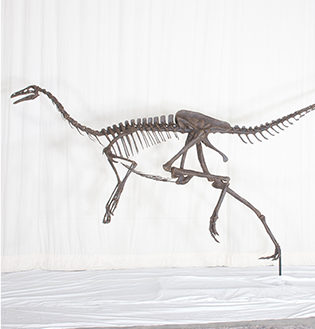Favorite CollLection Triceratops Real Figure Keyring
$11.95

Struthiomimus sedens was obviously designed for speed. Its elongated lower leg, which is substantially longer than its upper leg, is an anatomical feature also present in some of today’s swiftest land animals, including the ostrich and the cheetah. This long legged dinosaur may have been the world’s fastest dinosaur. It is possible that Struthiomimus was capable of sprinting at speeds of up to 50 miles per hour. Struthiomimus sedens is a member of the group of theropods known as Ornithomimosaurs or bird mimic dinosaurs. The name Struthiomimus means “ostrich-mimic”. An Asian counterpart is Gallimimus, the famous running dinosaur of Jurassic Park fame. Struthiomimus is the largest of the North American ornithomimids and rivals the Gallimimus in overall size.
The Ornithomimids belong to a larger group of theropods, the “Arctometatarsalia”. A peculiar structural modification of the third metatarsal in their feet is common to all these theropods. Such well known carnivorous dinosaurs as Albertosaurus and Tyrannosaurus rex are also members of this group. A similar adaptation is seen in the foot of the Oligicene and Miocene 3-toed horses.
Two other unusual characteristics of Struthiomimus are the complete absence of teeth in the skull and the presence of gastroliths (gizzard stones) in the digestive tract of at least one specimen. These discoveries lead some paleontologists to conclude that Struthiomimus was herbivorous. Other paleontologists, however, note the presence of three wickedly long, sharp claws on each of this dinosaur’s hands – equipment which seems quite capable of catching, holding and shredding prey. These saber sharp claws and the tremendous speeds this animal could probably attain point to the conclusion that Struthiomimus was omnivorous or perhaps carnivorous.
Struthiomimus sedens is only found in the Late Cretaceous Hell Creek and Lance Creek Formations or equivalent age rocks of Canada and the United States. These formations lie very near the K/T Boundary – the geologic line that marks the extinction of all the non-avian dinosaurs. Along with its contemporaries: Tyrannosaurus rex, Triceratops, Edmontosaurus, Thescelosaurus, Chirostenotes, Pachycephalosaurus, Dromaeosaruus, and Eupachycephalus; Struthiomimus perished at the end of the Cretaceous Period about 65 million years ago.
Struthio IconThis Struthiomimus sedens skeleton, the most complete excavated to date, has now been prepared, molded and cast by Black Hills Institute staff. This reproduction is the only freemount reconstruction of this dinosaur presently available from any source. The death pose exhibit shows the skeleton lying in the matrix as originally excavated. As a stand alone exhibit or as part of a larger “End of the Age of Dinosaurs” exhibit, the Struthiomimus skeleton is an exciting and educational piece.